- Home
- 3D Printers & AM Systems
- Arcam EBM Q10plus
- Arcam EBM Spectra L
- Arcam EBM Spectra H
- EP-A350 Resin (SLA)
- EP-A450 Resin (SLA)
- EP-A650 Resin (SLA)
- EP-A800 Resin (SLA)
- Lodestar S300
- Lodestar S400
- WaxJet 400
- WaxJet 410
- Sharebot Desktop System
- TPM P260
- TPM P360
- TPM P550
- TPM P320 HT [PEEK]
- EP P420 SLS 3D Printer
- EP P3850 SLS 3D Printer
- PCM 800
- PCM 1200
- PCM 1800
- PCM 2200
- EP-C5050
- EP-C7250
- EP-M150 [single/dual laser]
- EP-M260 [single/dual laser]
- EP-M300 [single/dual laser]
- EP-M450 [dual/quad laser]
- EP-M650 [dual/quad laser]
- EP-M150 Dental [single/dual laser]
- EP-M150 Pro [single/dual laser]
- Sharebot Metal One
- FUNMAT HT
- FUNMAT 410 PRO
- FUNMAT PRO 610 HT
- InnovatiQ X 500 Pro
- Slash 2 +
- Uniz NBEE
- Shinning 3D AccuFab-L4D
- NXE 200
- NXE 400
- XiP
- NXD 200
- QLS 820
Electron Beam Melting (EBM) Systems
SLA Systems (VAT Based Industrial Grade)
High Precision Wax : MJP
SLS (Polymer) Systems
Binder Jet/PCM (Sand Casting)
Investment Casting
Metal 3D Printers & AM Systems (Laser)
FFF/Filament (FDM) 3D Printers & AM Systems
High Precision Dental 3D Printer
Nexa 3D Printers
- 3D Scanner/3D Digitizing Solution
- FreeScan Trak
- FreeScan UE Pro
- FreeScan UE
- Autoscan Inspec
- RobotScan E0505 Robot Automatic 3D Scanning System
- OptimScan-5M Metrology 3D Scanner
Portable Wireless Optical Coordinate Measuring System
High Precision Laser Handheld 3D Scanner
High-Precision 3D Inspection Scanner - Software
- Applications
- Material
- Company
Amphyon
Simulation-based process preparation software for Laser Beam Melting: Additive Manufacturing Software Solution of Tomorrow.
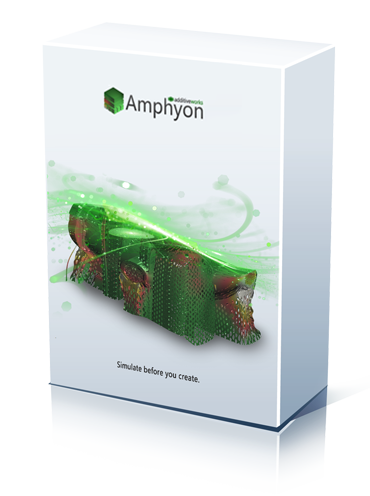
Additive Works provides software solutions aiming at a "first-time-right" additive manufacturing process by integrating new analysis and simulation tools into the process chain of Laser Beam Melting processes (LBM, SLM, DMLS, Metal 3D Printing). Driven by current requirements and challenges of industrial additive manufacturing, the software suite Amphyon aims to significantly reduce pre-processing costs and take metal AM to the next level of automation. Amphon follows the ASAP-Principle, the four ideal steps on the way to a stable, efficient and reliable process chain: Assessment, Simulation, Adaption and the Process itself.
Get a Quote +91 9900003300 Download Application Notes & PdfExaminer
Application specific optimization of build-up orientation based on the analysis and evaluation of required Support volume, Build time, Surface accessibility, Distortion sensitivity and Post-processing effort for every orientation.
Support volume
- Calculates required support volume for all orientations
- Customizable overhanging angle and support density
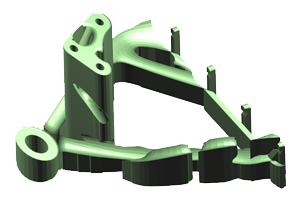
Build time
- Estimates the built time for all orientations
- Considers support volume and recoating time
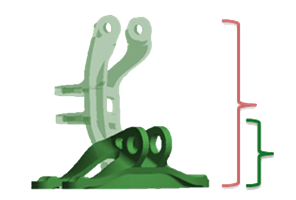
Surface accessibility
- Calculates the accessibility of the model surface
- Highlights problematic areas
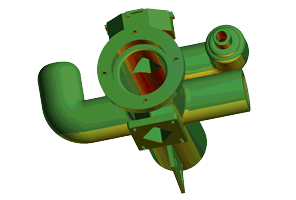
Distortion susceptibility
- Calculates the distortion tendencies for all orientations
- Fast simulation based estimation within minutes
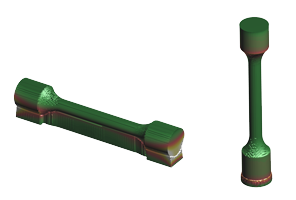
Post-processing effort
- Combination of accessibility and support areas
- Helps to avoid problems with support removal
- Displays regions with potential surfaces finishing problems
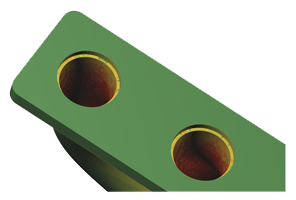
Support
Generation of optimized support structures that adjust support perforation and interfaces between part and support structure according to the loads that occur during the build-up process (MPS-Module required).
Design-space definition
- Easy 3D definition of the design-space
- Can be generated by e.g. overhanging angle criterium
- Allows externally created STLs as design-space
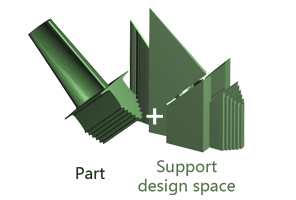
Optimization
- Uses default support parameters as initial values
- Implements physics-based optimization
- Calculates optimal parameters in support-space
- Ensures process stability
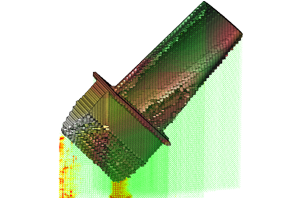
Support creation
- Support model geometry will automatically be created
- Resulting supports can be exported as 2D STL file

Support geometry
- Support structure is fragmented for easy removal
- Wall perforation for good powder removal
- Outer contour can be added for increased stability
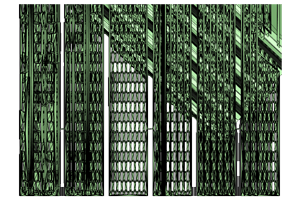
Interface adaption
- Easy removal of the support structure from part
- Interfaces are adapted to avoid delamination
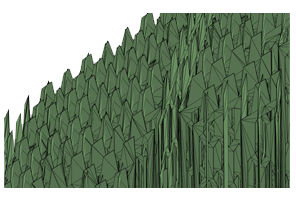
Mechanical Process Simulation
Fast mechanical simulation of the laser beam melting process, calculating the residual stress and distortion fields on regular desktop hardware.
Experimental calibration
- Calibration based on an easy to print small geometry
- Takes simple optical measurement as input
- Fully automated routine
- No complex micro-scale simulations necessary
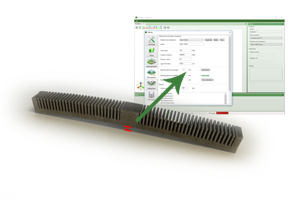
Advanced meshing algorithms
- Cutting edge meshing algorithms for accurate surface
- Creates homogenized elements for filigree supports
- No Finite-Element knowledge necessary
- Easy to auto-mesh function
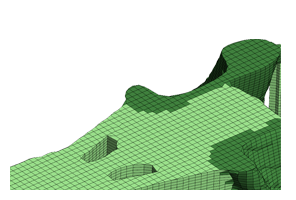
Mesh size independency
- No dependency on meshed layer thickness
- Reproducable result values with different meshes
- Simulation on coarse meshes possible for large structures

Usage of massive parallelization
- Easy setup with OpenCL or CUDA
- Optimized for CAD workstation hardware
- Fast calculation of real parts and support structures
- Calculates on CPUs or GPUs

Basis for further modules
(Additional modules required)
- Compensation of distortions with Pre-deformation Module
- Optimization of supports with Support Generation Module
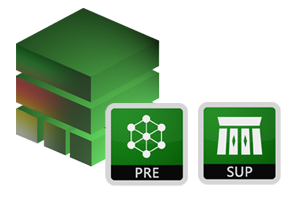
Thermal Process Simulation
Fast thermal simulation of the laser beam melting process, calculating the temperature history and field on regular desktop hardware.
Analysis of printjob setup
- Get build time estimation
- Estimate thermal behavior of print job
- Identify process phases with very high build rates
- Consider multi-laser systems

Identification of suitable process parameters
- Compare different machine settings
- Find minimum layer time necessary for thermal stability
- Find nesting for thermal stability
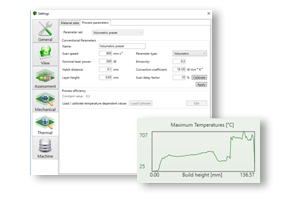
Identification of critical areas in parts
- Analyze macroscopic thermal field throughout process
- Identify where additional supports may be required
- Get fast overview of critical areas of design
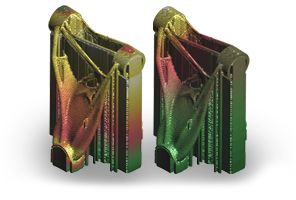
Extremely fast prediction of temperatures
- Calculates on CPUs or GPUs
- Optimized for CAD workstation hardware
- Analyze even very complex structures within minutes
- Run different setups without the need for long computations
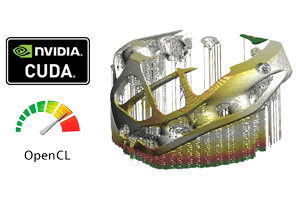
Experimental calibration
- Easy improvement of presets if measurements exist
- Avoidance of overcomplex and unknown model parameters
- Standardized test specimen
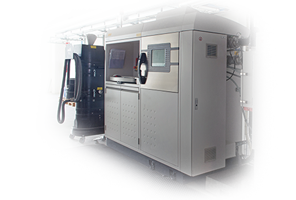
Predeformation
One-click solution to pre-compensate residual distortions by adapting the build-up geometry (MPS-Module required).
Compensation of build distortions
- Modifies STL using distortion values after buildup
- Compensates irreversible process distortions
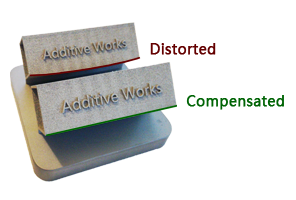
Compensation of residual distortions
- Modifies STL using final distortion values
- Compensates irreversible distortions by stress relaxation
- Cutting direction and heat treatment can be considered
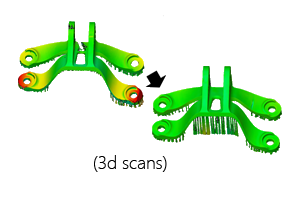
Modification of supports
- Modifies STL of the support structure
- "Ready for manufacturing" supports with pre-deformation
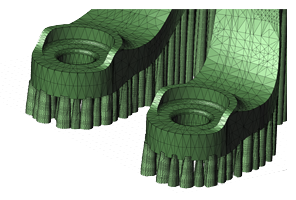
Automated STL refinement
- Configurable degree of refinement
- Adaptive method based on local deviation

Comparison of simulation and process
- Export of deformed models and supports as STL
- Analysis of the distorted shape (ext. software required)
- Direct comparison with 3D scans (ext. software required)
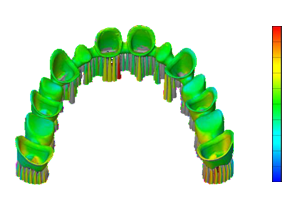
Read
Latest News
XJet Partners with Straumann to Boost Ceramic AM from Concept to Production - MANUFACTUR3D Read More
Legendary Damascus steel 3D printed by varying temperature of layers Read More
3D Printing in Education Market 2020 In-Depth Analysis of Industry Share, Size, Growth Outlook up to 2025 Read More
Ceramic 3D Printing Market Manufacturer Analysis and Segmentation from 2020-2026 | 3D Cream, Admatec, Emerging Objects Read More
Electron Beam Melting (EBM) Systems
SLA Systems (VAT Based Industrial Grade)
High Precision Wax : MJP
SLS (Polymer) Systems
High Precision Dental 3D Printer & AM Systems
Metal 3D Printers & AM Systems (Laser)
FFF/Filament 3D Printers & AM Systems
Copyright © 2024 Lodestar Innovations Private Limited. All rights reserved.
